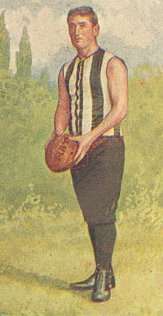Ted Rowell (footballer)
Edward Michael "Ted" Rowell (15 June 1876 – 21 July 1965)[1] was an Australian rules footballer who played for the Collingwood Football Club in the Victorian Football League (VFL).[2]
| Ted Rowell | |||
|---|---|---|---|
 | |||
| Personal information | |||
| Full name | Edward Michael Rowell | ||
| Date of birth | 15 June 1876 | ||
| Place of birth | Vaughan, Victoria | ||
| Date of death | 21 July 1965 (aged 89) | ||
| Place of death | Kew, Victoria | ||
| Original team(s) | Kalgoorlie | ||
| Playing career1 | |||
| Years | Club | Games (Goals) | |
| 1901–1915 | Collingwood | 189 (175) | |
| Coaching career | |||
| Years | Club | Games (W–L–D) | |
| 1907–1908 | Collingwood | 12 (6–6–0) | |
|
1 Playing statistics correct to the end of 1915. | |||
| Career highlights | |||
| |||
| Sources: AFL Tables, AustralianFootball.com | |||
Early life
Born in Victoria, Australia (or Kalgoorlie, Western Australia according to another source), as a teenager in the 1890s Rowell was attracted to the goldfields in Western Australia and as a youngster was proficient in cricket, foot running and Australian rules football. Playing in the Kalgoorlie-based Goldfields Football League for five years, Rowell booted over 250 goals, which earned him representation in Perth in the first Australian rules goldfield representative side in 1896.
VFL career
Rowell made his VFL debut with the Collingwood Football Club during the 1901 VFL season (at 24 years of age).[3] He was not an overly tall player at 178 cm and weighing 80 kg but his great advantage was his speed (which had also been useful in his career as a professional runner). Rowell scored 31 goals in the 1901 season and 33 goals in 1902, playing as a key position forward.
Rowell played in the 1903 Collingwood premiership side before moving back to Western Australia in 1904, however this was only a one-off and he attempted a return to Collingwood in 1905, but for the League not allowing a permit for him to play. He sat out the 1905 season but returned in 1906. In 1907 Rowell was switched to defence where he became one of the first truly attacking full-backs. Prior to this full-backs did not create run out of defence and acted more like a goalkeeper. He remained a full-back until 1914. Trademarks of his play would be to "tap the ball to himself and run along the wing" as well as his placekicking, which travelled 60 yards.
In 1907 and 1908 Rowell was the acting playing-coach of Collingwood. He added to his 1903 success as a player with another premiership in 1910. In 1914 Rowell retired but made a surprise return in the 1915 VFL Grand Final where he was among the best players in a loss for the Magpies.
During a 1912 match for Collingwood against Essendon Football Club, Rowell was involved in an unusual incident when he got his foot stuck in a drain pipe on the ground while running for the ball against his opponent. While Rowell struggled to free himself, his opponent casually picked up the ball and easily goaled.[4] A year earlier, in a match against Richmond, Rowell was attacked by a small dog during play.[5]
In the interstate arena, Rowell played 7 games for Victoria for 7 goals. For Collingwood, he played 189 games for 175 goals.
Rowell was also a noted athlete who once raced world record holder Jack Donaldson over 100 yards at halftime of a Collingwood match Rowell played in. Rowell narrowly lost, having just played 50 minutes of football.[6]
Retirement/death
He later wrote a series of sporting articles and never lost his love for the black and white. He died at 90 years of age.
References
- "Ted Rowell". Collingwood Forever. Retrieved 26 August 2014.
- "Ted Rowell - Stats - Statistics". AFL Tables. Retrieved 26 August 2014.
- Rowell is one of the three Collingwood footballers (the others were Charlie Pannam and Dick Condon) responsible for the development of the stab-kick; see "'The Stab Kick' — A Football Development", The Argus, (Monday 27 June 1910), p.6.
- Atkinson, p. 166.
- Atkinson, p. 167.
- Atkinson, p. 178.
- Bio at FullPointsFooty
- Football career profile
- Holmesby, Russell and Main, Jim (2007). The Encyclopedia of AFL Footballers. 7th ed. Melbourne: Bas Publishing.
Sources
| Wikimedia Commons has media related to Ted Rowell (footballer). |
- Atkinson, G. (1982) Everything you ever wanted to know about Australian rules football but couldn't be bothered asking, The Five Mile Press: Melbourne. ISBN 0 86788 009 0.